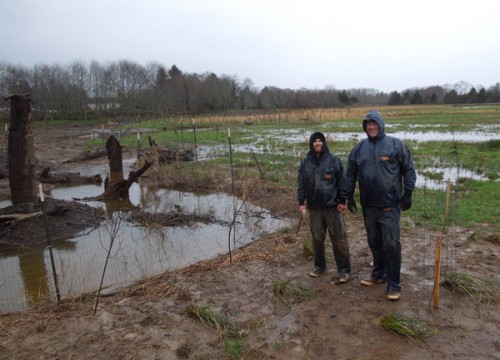Since acquiring the Thompson Creek / Stanley Marsh property in 2006, NCLC staff and volunteers have spent countless hours on restoration and stewardship of this unique and ecologically complex property. The results are clear and measurable – the beavers are building dams and creating ponds, birds are stopping by on their migratory routes, and the number of spawning Coho salmon have clearly increased.
The bulk of this work has been concentrated in the northeastern portion of the property closest to Thompson Creek, but the most recent project is focused on the large area of former wetland turned pasture that makes up the bulk of the property’s lower elevations closer to Stanley Lake. Recently I had the good fortune to get a tour, guided by Casey Corkery and Austin Tomlinson.

Undaunted by the cold rainy December weather, Austin Tomlinson (left) and Casey Corkery work to complete the current restoration project at Stanley Marsh.
Funding, design and implementation were provided by a partnership that included developer Casey Corkery, wetlands consultant Doug Ray (Carex Consulting), Austin Tomlinson, Trout Unlimited, and other individuals and groups. The project’s goal is to restore much of the flat and drained pastureland back into a functioning sitka spruce wetland, and consists primarily of opening up the ditch that runs along the eastern and southern edge of the pasture. “Ditch Creek” is a man-made ditch that channels the water from Thomson Creek and several other draws around the pasture to Stanley Lake, and by widening the ditch and creating meanders, hillocks and swales, the water is being released into the pasture, helping to restore it back into a functioning wetland. Woody debris (logs and stumps) have been added, along with plantings of willow, alder, spuce, and other wetland vegetation to provide a head start for the habitat. As Doug Ray says, “We don’t try to create a wetland, we just get things going in the right direction and nature does the rest!” A side benefit of all of this is that the restored wetland acts as a buffer during high-water events, potentially reducing flooding in surrounding neighborhoods.
The results are already clearly evident. The water is cutting new side-channels on its own, there is evidence of beaver moving in, invasive reed canarygrass is being drowned, and the whole area already looks more like a wetland than a pasture.
It’s an exciting project to watch, and we can definitely look forward to some opportunities to learn and participate — check the “On the Land” and “Stewardship Days” schedules to see how you can participate.
(Note: the Daily Astorian recently published an article about this project — follow this link to read more.)
Comments